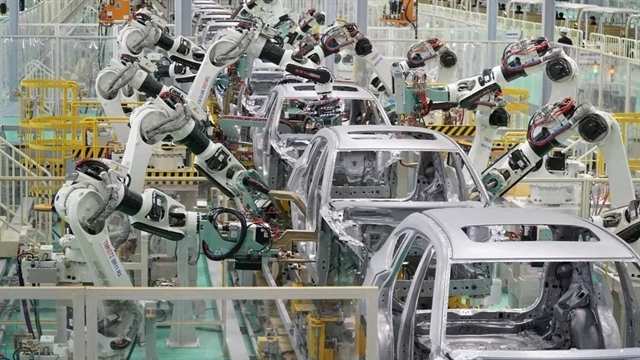 Economy
Economy

 |
| Production at Huyndai Thành Công, Ninh Bình. — VNA/VNS Photo |
HÀ NỘI — The demand for transport in Việt Nam has been increasing rapidly, with experts saying that the market shows a lot of potential for automobile and motorbike manufacturers and traders.
With new policies in effect and businesses working to expand factories and assembly lines and gradually catch up with global trends, the Vietnamese automobile industry has achieved positive results.
In particular, the localisation rate is growing as more and more businesses invest in domestic car production.
New Government policies and increasingly clear trends in foreign investment flows all show a brighter picture for the car and motorbike support industries in Việt Nam.
According to data from the Ministry of Industry and Trade, the export turnover of electrical wire components reached about US$1.17 billion last year, accounting for 38 per cent of the export value of automobile components and ranking third in the world.
Vietnamese-made electrical wire products have become an important link in the global supply chain of automobile assembly materials.
Dr Trương Thị Chí Bình, deputy general secretary of the Việt Nam Association for Supporting Industries (VASI), said that the total value of automobile industry-related products has grown rapidly in recent years, up from a 12 per cent growth rate in 2018 to 25 per cent last year.
At the same time, firms looking to improve product value are focusing on producing component clusters instead of individual spare parts, starting with original equipment manufacturer (OEM) and moving towards original brand manufacturer (OBM) products, she added.
The Xây dựng (Construction) online newspaper quoted Nguyễn Công Quyết from the Việt Nam Automobile Manufacturers’ Association (VAMA) as saying that the Vietnamese automobile market has a lot of potential, thanks to a population of 100 million people and a rising average income.
However, the supporting industry is still in the first maintenance phase, with enterprises mainly producing low-value and non-competitive components, he said.
One of the main problems is the small size of the automobile market, leading to lower production and difficulty in developing the supply chain.
As for the development of the global auto industry supply chain in the context of adapting to climate change, the VAMA representative said that about 30,000 components were needed to produce and assemble a complete car.
The automobile industry therefore requires a large industrial foundation, he noted.
Dr Bình said that car component production in Việt Nam was divided into two branches: high-value activities, carried out by FDI enterprises and major domestic brands, and low-value activities, concentrated in small and medium-sized enterprises.
Many of them are falling into the 'low productivity trap'. Promoting a comprehensive transformation of this sector -- from purpose to process and people -- is therefore necessary, she noted.
According to the VAMA representative, the business community is waiting for a system of synchronous and breakthrough incentive policies to invest in the production and assembly of green vehicles.
The policies must encourage and mobilise the participation of all economic sectors in the country, promote cooperation with major global car manufacturers, and focus on improving companies' competitiveness to participate in the global automobile industry production chain, he emphasised.
At the same time, they must also improve competitiveness to become a supplier of components and spare parts in the global automobile production chain, creating a driving force to promote the economic restructuring of the whole country towards modernisation. — VNS